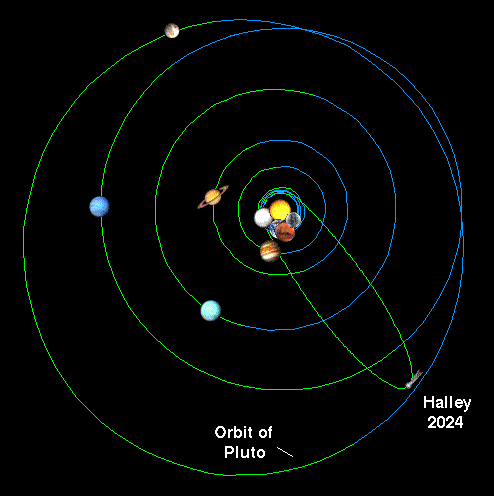In 1705, Edmond Halley used Newtonian theory and predicted the return of a comet seen in 1682. It did return as predicted, in 1758, putting Halley on the stellar map and driving a stake into the evil hearts of competing theories to Newton.
Once it was possible to projects visits forward in time it was also possible to project them backward and Halley's Comet was correlated to any number of events, such as William the Conqueror's Norman invasion of England in 1066, portrayed in the Bayeux Tapestry - the end of Anglo-Saxon rule.
But backward projection is an imperfect craft because Halley's Comet travels near planets and their gravity impacts its course - instead of every 75 years it can be 74 or 76 or even 79.

Where Halley will be in 2024 - Pluto, though it's not a planet any more, claim 2% of astronomers.
Computer models calibrated for alterations in the comet's orbit matched with recorded sightings have shown the dates for visits back into the third century BC. - we are fortunate to have records kept by the Babylonians and Chinese, who took notes of daily events in the heavens for centuries.
The earliest sighting recorded is believed to be 240 BC, by the Chinese, but projections for appearances by Halley's comet have been done back to 1404 BC - yet no documentation exists before the Chinese. The Greeks, though highly regarded as astronomers, did not keep records like the Babylonians and Chinese, making projections difficult to verify because there are no records to help calibrate the appearances. They basically had nothing to work with, as later people did. But maybe they did leave clues to a Halley's Comet sighting behind.
In 467/6 BC, a meteor fell in the Hellespont region of northern Greece, the authors write, and it began the age of meteor theory. It may also have been predicted.
The Greeks report that Anaxagoras of Clazomenae, in the second year of the 78th Olympiad [467/6] predicted, by his knowledge of astronomical writings, within what days a stone would fall from the sun, which happened in the daytime in a region of Thrace on the Aegos river. The stone is still exhibited, being about the size of a wagon load, of a burnt color, which fell while a comet was seen burning in the night (Pliny Natural History 2.149 = DK 59A11).In Meteorology a hundred years later, Aristotle wrote that when the meteor fell a comet was visible in the west. The term comet was not used by Anaxagoras but
Plutarch, writing in the late first or early second century, himself a well-read scholar familiar with astronomical theories in general and Anxagoras' in particular, gives a brief summary of Anaxagoras' theory and repeats a description of the comet from an earlier historian. He makes it clear that it was Anaxagoras' theory that predicted the possible fall of a meteorThe calculations of Graham and Hintz show that Halley's Comet would have been visible for 75 days in 466 BC (modern months June to August), lending weight to claims that the Greeks may have been the first to record it. If so, the first recorded sighting of Halley's Comet just got pushed back 226 years - and it may be even be Anaxagoras' Comet instead.
Citation: Daniel W. Graham, Eric Hintz, 'An Ancient Greek Sighting of Halley's Comet?', Journal of Cosmology, 2010, Vol 9, 3030-3036 (open access!)





Comments